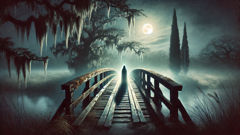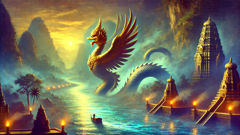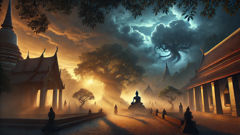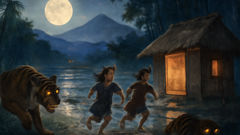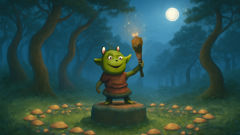Introduction
There’s a hush that settles over the cypress-shaded banks of the Medina River as dusk deepens into night. The air grows heavy with the scent of moss and earth, the only sounds the slow trickle of water and the restless whisper of leaves. Locals know not to linger too long here, especially at the weathered bridge that curves over the dark water like a spine. It’s here, in the outskirts of San Antonio, that a legend has taken root for generations—a story that seems to live in the landscape itself, surfacing whenever night falls and courage is tested. They call it the Donkey Lady Bridge, and few places in Texas inspire such a tangle of curiosity, dread, and fascination. Tourists often arrive by daylight, snapping photos and laughing off the warnings of those who know better. But as evening comes, even the boldest feel the prickle of unease, recalling tales whispered at campfires and family gatherings: stories of a woman wronged, her flesh warped into something both human and not, doomed to haunt the bridge that saw her tragedy. Some say she’s seeking justice. Others believe she can’t let go of her pain. Every detail of her legend is colored by the shadows of history—echoes of cruelty, love, and sorrow that transcend the boundaries of time. For San Antonio, the Donkey Lady is more than just a ghost; she’s a symbol of the city’s haunted past and enduring folklore, a presence that binds the living and the dead in a perpetual dance of fear and wonder.
Origins in Ashes: The Woman Behind the Legend
Long before the bridge became infamous, the land around the Medina River was wild and largely unclaimed. The mid-1800s brought settlers chasing fertile ground and fresh beginnings. Among them was a woman named Isabella, remembered for her gentle nature and fierce loyalty to her young family. Isabella’s husband was a farm laborer; their days revolved around tending a patchwork of fields, raising goats and, crucially, a pair of stubborn donkeys that were the backbone of their livelihood. Life was hard, but hope was resilient, thriving in the laughter of their two children and the chorus of dawn birds along the river.
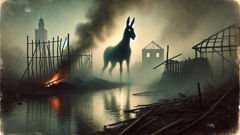
Yet frontier Texas was a place of both opportunity and peril. Prejudice simmered beneath the surface, igniting tensions between settlers and newcomers, and Isabella’s family—of mixed Mexican and Spanish heritage—often found themselves targets of whispered slights and resentful glances. One spring, an escalating feud with a neighboring rancher came to a head. The rancher’s sons, resentful and reckless, accused Isabella’s donkeys of trampling their fields. One moonless night, they stormed across the property line, setting fire to the family’s modest home as Isabella’s children slept inside. She fought to save them, her screams echoing through the night as flames devoured wood and flesh. By dawn, the house was gone. Her husband and children perished, and Isabella herself was left horribly burned. The neighbors found her wandering by the riverbank, her hands and face twisted beyond recognition, her grief inhuman.
Whispers spread quickly. Some claimed Isabella had been cursed for her stubbornness. Others insisted she’d made a pact with dark forces to survive such agony. But the truth was simpler and far crueler: grief had transformed her, driving her to the wild edges of sanity. When she disappeared into the woods days later, no one searched too hard. The river washed away the ashes, but not the memory. Over time, children dared each other to cross the bridge at night, swearing they’d heard hooves clattering where no animal walked. Some even saw a hunched shape lurking among the trees, eyes glowing with a desperate, unnatural light. Thus was born the legend of the Donkey Lady—a spirit neither wholly woman nor beast, bound to the bridge by sorrow and rage.
Encounters on the Bridge: Stories Passed Down
Decades blurred the details, but the Donkey Lady’s reputation only grew with time. By the 20th century, the area around the bridge was thick with stories—each more unsettling than the last. Local families warned their children not to linger after dark, recounting encounters that ranged from fleeting glimpses to outright terror.
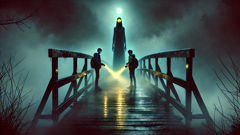
In the 1950s, a pair of teenage brothers—Tomás and Jorge—decided to brave the bridge after midnight, egged on by their friends’ taunts. They crept along the boards, flashlights flickering, breath steaming in the cool night. Midway across, Tomás heard a guttural braying echo from below. The boys froze as a heavy, uneven clatter rang out—like hooves on rotted wood. A hunched figure rose from the shadows at the bridge’s end, its face hidden by matted hair. It moved with a strange, limping gait, and when Jorge’s light caught its eyes, they glowed with a furious, yellow light. The boys fled, swearing they felt hands—or hooves—grabbing at their clothes. For weeks afterward, nightmares haunted their sleep, and neither ever returned to the river alone.
Other tales followed. In the 1970s, a truck driver named Edna claimed she was forced to stop her rig on the bridge after something slammed against her windshield in the dead of night. She saw a hunched form limping in front of her headlights—a figure part-woman, part-beast. When she stepped outside to investigate, the air grew icy, her breath clouded, and the creature vanished into the fog. Edna’s story rippled through town, feeding late-night radio shows and campfire conversations.
Even modern-day paranormal investigators have braved Donkey Lady Bridge, setting up cameras and digital recorders in search of evidence. They return with garbled audio—distorted wails, echoing hoofbeats, and once, a woman’s voice crying for her children. Some skeptics dismiss these tales as overactive imaginations or clever pranks. But the persistence of the legend, passed down in so many versions, suggests there’s something about the bridge that refuses to be forgotten.
The Donkey Lady’s Shadow: Fear, Folklore, and the City’s Soul
What keeps a legend alive isn’t just fear—it’s the way stories become woven into daily life. For San Antonio, the Donkey Lady is more than just a warning to children or a campfire thrill. Her presence seeps into the city’s identity, shaping how residents see their landscape and history.
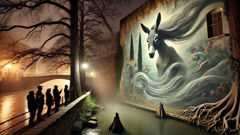
Local artists have painted haunting murals along riverside walls—depicting the Donkey Lady, half-hidden among cypress roots or reflected in nighttime waters. Her story inspires annual ghost tours, where guides lead visitors across the infamous bridge, reciting tales of Isabella’s doomed family and the spectral figure that sometimes appears in photos. On Halloween, groups gather in costumed bravado to test their courage, chanting her name into the night and daring her to show herself. Some leave offerings—candles, flowers, or even small carved donkeys—hoping to appease her restless spirit or maybe win her favor.
Teachers in San Antonio schools sometimes use the legend to spark discussions about bullying, prejudice, and empathy. Isabella’s suffering is reframed as a cautionary tale about the consequences of cruelty and exclusion. Folklorists trace the legend’s evolution, linking it to older Mexican and Spanish ghost stories of La Llorona and the Muladona, noting how each generation adapts the Donkey Lady’s pain to fit new anxieties and injustices.
Yet for all the analysis, there remains something primal about her story—a reminder that sorrow and rage, once unleashed, can linger for generations. The Donkey Lady embodies the city’s hidden wounds: the tragedies no one wants to claim, the injustices that echo long after they’re forgotten. Her bridge isn’t just a place on a map; it’s a threshold between the world as it is and the world as it might have been, if only kindness had prevailed.
Conclusion
Every city carries its own ghosts—stories that haunt not just places but hearts and memories. In San Antonio, the Donkey Lady is more than a tale to frighten outsiders; she’s a reflection of the city’s resilience, its wounds, and its unbroken ties to the past. Her legend grows not only from tragedy, but from the way people remember and retell her pain: with fear, empathy, and sometimes hope. On misty nights by the Medina River, as moonlight drapes over the old bridge, her presence is almost tangible—a whisper in the cypress, a chill across the skin. Whether you believe in the supernatural or not, standing on the Donkey Lady Bridge is a reminder that history never really fades. It lingers in the quiet places, shaping how a city sees itself and how its people confront darkness and loss. And perhaps that’s why her story endures: because it belongs to everyone who has ever loved, lost, or hoped for justice in the shadowy places where legends are born.

